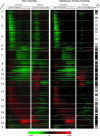Metabolic-state-dependent remodeling of the transcriptome in response to anoxia and subsequent reoxygenation in Saccharomyces cerevisiae
- PMID: 16963631
- PMCID: PMC1563586
- DOI: 10.1128/EC.00107-06
Metabolic-state-dependent remodeling of the transcriptome in response to anoxia and subsequent reoxygenation in Saccharomyces cerevisiae
Abstract
We conducted a comprehensive genomic analysis of the temporal response of yeast to anaerobiosis (six generations) and subsequent aerobic recovery ( approximately 2 generations) to reveal metabolic-state (galactose versus glucose)-dependent differences in gene network activity and function. Analysis of variance showed that far fewer genes responded (raw P value of <or=10(-8)) to the O(2) shifts in glucose (1,603 genes) than in galactose (2,388 genes). Gene network analysis reveals that this difference is due largely to the failure of "stress"-activated networks controlled by Msn2/4, Fhl1, MCB, SCB, PAC, and RRPE to transiently respond to the shift to anaerobiosis in glucose as they did in galactose. After approximately 1 generation of anaerobiosis, the response was similar in both media, beginning with the deactivation of Hap1 and Hap2/3/4/5 networks involved in mitochondrial functions and the concomitant derepression of Rox1-regulated networks for carbohydrate catabolism and redox regulation and ending (>or=2 generations) with the activation of Upc2- and Mot3-regulated networks involved in sterol and cell wall homeostasis. The response to reoxygenation was rapid (<5 min) and similar in both media, dominated by Yap1 networks involved in oxidative stress/redox regulation and the concomitant activation of heme-regulated ones. Our analyses revealed extensive networks of genes subject to combinatorial regulation by both heme-dependent (e.g., Hap1, Hap2/3/4/5, Rox1, Mot3, and Upc2) and heme-independent (e.g., Yap1, Skn7, and Puf3) factors under these conditions. We also uncover novel functions for several cis-regulatory sites and trans-acting factors and define functional regulons involved in the physiological acclimatization to changes in oxygen availability.
Figures







Similar articles
-
Dynamical remodeling of the transcriptome during short-term anaerobiosis in Saccharomyces cerevisiae: differential response and role of Msn2 and/or Msn4 and other factors in galactose and glucose media.Mol Cell Biol. 2005 May;25(10):4075-91. doi: 10.1128/MCB.25.10.4075-4091.2005. Mol Cell Biol. 2005. PMID: 15870279 Free PMC article.
-
Comparison of the transcriptomic "stress response" evoked by antimycin A and oxygen deprivation in Saccharomyces cerevisiae.BMC Genomics. 2008 Dec 23;9:627. doi: 10.1186/1471-2164-9-627. BMC Genomics. 2008. PMID: 19105839 Free PMC article.
-
Genomic analyses of anaerobically induced genes in Saccharomyces cerevisiae: functional roles of Rox1 and other factors in mediating the anoxic response.J Bacteriol. 2002 Jan;184(1):250-65. doi: 10.1128/JB.184.1.250-265.2002. J Bacteriol. 2002. PMID: 11741867 Free PMC article.
-
Regulation of gene expression by oxygen in Saccharomyces cerevisiae.Microbiol Rev. 1992 Mar;56(1):1-11. doi: 10.1128/mr.56.1.1-11.1992. Microbiol Rev. 1992. PMID: 1579104 Free PMC article. Review.
-
Oxygen sensing and the transcriptional regulation of oxygen-responsive genes in yeast.J Exp Biol. 1998 Apr;201(Pt 8):1177-95. doi: 10.1242/jeb.201.8.1177. J Exp Biol. 1998. PMID: 9510529 Review.
Cited by
-
Mitochondrial Retrograde Signaling Contributes to Metabolic Differentiation in Yeast Colonies.Int J Mol Sci. 2021 May 25;22(11):5597. doi: 10.3390/ijms22115597. Int J Mol Sci. 2021. PMID: 34070491 Free PMC article.
-
Confirmation of organized modularity in the yeast interactome.PLoS Biol. 2007 Jun;5(6):e153. doi: 10.1371/journal.pbio.0050153. PLoS Biol. 2007. PMID: 17564493 Free PMC article. No abstract available.
-
Transcriptional response to mitochondrial NADH kinase deficiency in Saccharomyces cerevisiae.Mitochondrion. 2009 Jun;9(3):211-21. doi: 10.1016/j.mito.2009.02.004. Epub 2009 Feb 28. Mitochondrion. 2009. PMID: 19254780 Free PMC article.
-
The nuclear localization of SWI/SNF proteins is subjected to oxygen regulation.Cell Biosci. 2012 Aug 29;2(1):30. doi: 10.1186/2045-3701-2-30. Cell Biosci. 2012. PMID: 22932476 Free PMC article.
-
Role of heme in the antifungal activity of the azaoxoaporphine alkaloid sampangine.Eukaryot Cell. 2008 Feb;7(2):387-400. doi: 10.1128/EC.00323-07. Epub 2007 Dec 21. Eukaryot Cell. 2008. PMID: 18156292 Free PMC article.
References
-
- Andreasen, A., and T. Stier. 1953. Anaerobic nutrition of Saccharomyces cerevisiae. I. Ergosterol requirement for growth in a defined medium. J. Cell. Comp. Physiol. 41:23-36. - PubMed
-
- Andreasen, A., and T. Stier. 1954. Anaerobic nutrition of Saccharomyces cerevisiae. II. Unsaturated fatty acid requirement for growth in defined medium. J. Cell. Comp. Physiol. 43:271-281. - PubMed
-
- Bailey, T. L., and C. Elkan. 1994. Fitting a mixture model by expectation maximization to discover motifs in biopolymers. Proc. Int. Conf. Intell. Syst. Mol. Biol. 2:28-36. - PubMed
Publication types
MeSH terms
Substances
Grants and funding
LinkOut - more resources
Full Text Sources
Other Literature Sources
Molecular Biology Databases
Research Materials
Miscellaneous

